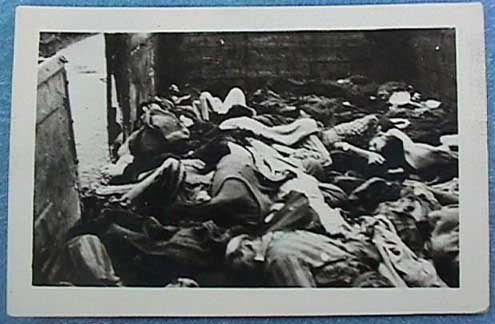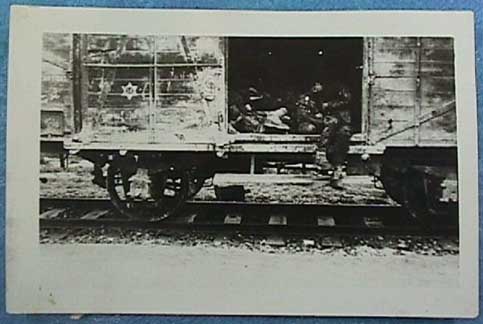The Dachau Death Train, continued...Previous The photograph above shows some of the dead prisoners on the Death Train that was found by soldiers of the US Seventh Army on April 29, 1945, the day that the concentration camp at Dachau was liberated. These prisoners had been evacuated from the Buchenwald concentration camp on April 7, 1945 before that camp was liberated; they died on the way to Dachau when the trip took much longer than expected, due to Allied bombing of the railroad tracks. In the center of the photo is a bucket, which was probably used for either water or a toilet facility. A pan, that was possibly used for food, is in front of the bucket. Note the open boxcar which provided no protection from strafing by American planes. According to testimony in the trial of Hans Merbach, the transport leader, the prisoners were forced to stay on the train when it was attacked by American planes, while the SS guards took cover. In a book called "The Last Days of Dachau," written by Dr. Ali Kuci, a Dachau survivor from Albania, and Arthur Haulot, a Belgian prisoner at Dachau, the authors wrote that the train had arrived at noon on April 27, 1945 with 1,600 survivors out of 2,400 prisoners who had started on the journey from Weimar. Marcus J. Smith wrote that these figures were changed, after the war ended, to 2,000 to 2,500 survivors out of 6,000 who had been put on the train. A typical transport of prisoners consisted of 60 cars with 100 prisoners in each car. The Death Train passengers were among 7,000 prisoners who made it to Dachau alive when they were evacuated from other camps in the final three weeks before the Americans arrived. There was a total of 14,000 prisoners who had been brought to Dachau in the final two months before the camp was liberated. Another train, which had left Buchenwald around the same time, made it to the Theresienstadt camp in Czechoslovakia, which had already been turned over to the Red Cross by the Nazis, and would soon be liberated by Soviet troops. According to author Sam Dann, there were exactly 2,310 bodies on the train. However, at the trial of 40 staff members of the Dachau camp, before an American Military Tribunal in November 1945, the first witness for the prosecution, Col. Lawrence Ball, an officer in the Army Medical Corps, testified that he had arrived at Dachau two days after the camp was liberated and had seen 38 cars with 10 to 20 corpses in each car. That figures out to approximately 380 to 760 dead bodies on the train. There was no testimony during the American Military Tribunal at Dachau about the 2,310 bodies allegedly counted on the train. Nerin E. Gun, a Turkish newspaper correspondence who was a prisoner at Dachau, wrote the following in an article for the U.S. 45th Division News: There they found some fifty-odd cattle cars parked on the tracks- the cars were not empty. The train was full of corpses, piled one on the other, 2310 of them to be exact. The train had come from Birkenau and the dead were Hungarian and Polish Jews, children among them. Their journey had lasted perhaps thirty or forty days. They had died of hunger, of thirst, of suffocation, of being crushed or of being beaten by the guards. There were even evidence of cannibalism. They were all practically dead when they arrived at Dachau station. The SS did not take the trouble to unload them. They simply decided to stand guard and shoot down any with enough strength left to emerge from the cattle cars. The corpses were strewn everywhere on the rails, the steps, the platforms. "I never saw anything like it in my life," said Lieutenant Harold Mayer, "Every one of my men became raving mad." Contrary to Gun's report, the prisoners on the train were from Buchenwald, but they may have been in Birkenau (Auschwitz II) before being transferred to Buchenwald. Gleb Rahr, one of the survivors, said that 1,300 survivors from the Death Train were lined up and counted at the gate into the Dachau camp, and "another fifteen hundred or so, remained on the train. They were dead on arrival. Some two thousand others died en route." A newspaper article about the liberation of Dachau, written by Howard Cowen, said that only half of the boxcars had dead bodies in them. Some of the prisoners on the train had been shot by the guards along the way when they attempted to escape from the open boxcars. Gleb Rahr recalled that the SS shot everyone in one of the cars because there was some sort of escape attempt. Others had been killed in fights between the prisoners who tried to steal the bread that some had attempted to save for later. Some of the bodies were naked because their clothing had been removed by the other prisoners in an effort to keep warm in the open cars. Even though it was Spring time, it was still cold and snowing in Germany in April 1945. Several eye-witnesses mentioned that they saw prisoners from the train who were lying on the ground in front of the boxcars with their heads bashed in and their brains oozing out onto the ground. The Death Train was on a city street in the town of Dachau, and no one knows how or why these unfortunate prisoners were killed. The "Death Train" made a lasting impression on all the American soldiers who witnessed it. In a letter to Headquarters, Col. Walter J. Fellenz wrote the following on 6 May 1945 under the heading "Subject: Impression of The Dachau Concentration Camp, 1. The Dead Bodies in the Box Cars": It was like approaching a rail siding in any small-size Western town where the appearance of thirty or forty box cars on a single track, lonely and desolate, is not a sight uncommon. As I neared the cars, however, I saw death and destruction of human lives at its height. Each of the thirty to forty cars contained the skin and bones of men and women, thousands of them, half-clothed in rags - dead. Upon closer inspection of the bodies, I found many contained bullet holes. I was later informed by inmates that the SS required the prisoners to lie flat in the cars. From time to time, they would inspect the cars; any person not in the prone position, was shot without question, and left in the car. In the 42nd Rainbow Division newsletter, Tec 3 James W. Creasman wrote the following on May 1, 1945: Ten days before the arrival of the Rainbow Division fifty carloads of prisoners arrived at Dachau from the Buchenwald concentration camp in a starving condition after 27 days without food. When Buchenwald was threatened by advancing American troops the Nazis hurriedly crowded about 4,000 of their prisoners into open flatcars unfit even for cattle. 27 days later - days of exposure to freezing weather without anything to eat, a trainload of human suffering arrived at Dachau only to be left to die in the railyard leading into this extermination camp. In those stinking cars were seen the bodies of these prisoners too weak even to get out. A few tried, and they made a bloody heap in the door of one of the cars. They had been machine gunned by the SS. A little girl was in that car. In another car, sitting on the bodies of his comrades, his face contorted with pain frozen by death, was the body of one who completed the amputation of his gangrenous leg with own (his) hands and covered the stump with paper. Underneath was one with a crushed skull. "He's better off now." was the comment of one newsman. Close by was one who had been beaten until his entrails protruded from his back. But most of them had simply died in the attitudes of absolute exhaustion that only starving men can assume. Curled up with their faces resting in fingers tipped with blue nails. With naked buttocks angling up to pivot on a skeletal pelvis. Or twisted over to show on (sic) abdomen stretched drum-tight against the spine with ribs making an overhanging bulge. The two photographs below are from the G.J. Dettore Collection. They were taken by an American soldier in early May, 1945 after the liberation of Dachau. The bodies had been left just as they were found by the American liberators until a full investigation could be conducted by the US Army.   ContinuePreviousBack to Liberation of DachauBack to Table of ContentsBack to Dachau indexHomeThis page was last updated on April 3, 2008 |